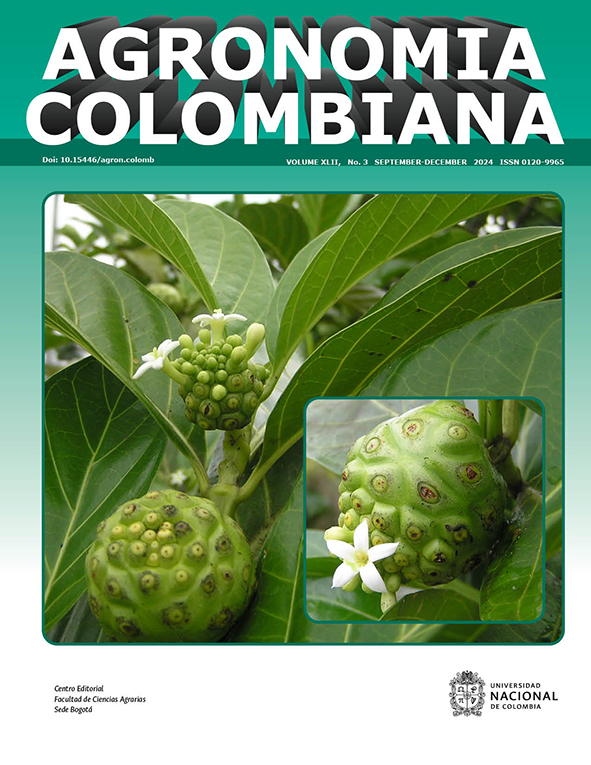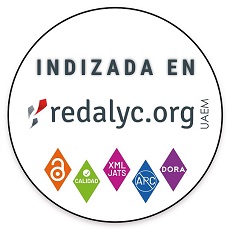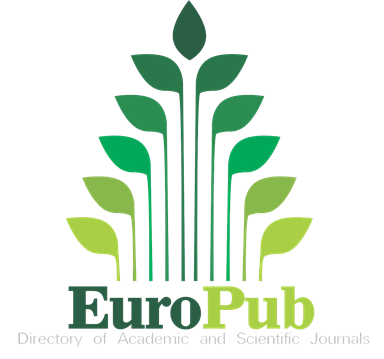Selection of resistance inducers for managing Hemileia vastatrix Berk. & Br. in coffee (Coffea arabica L.) seedlings
Selección de inductores de resistencia para el manejo de Hemileia vastatrix Berk. & Br. en plántulas de café (Coffea arabica L.)
DOI:
https://doi.org/10.15446/agron.colomb.v42n3.116907Keywords:
acibenzolar-S-methyl, coffee leaf rust, urediniospores, germination, disease severity (en)acibenzolar-S-metil, roya del café, urediniosporas, germinación, severidad de la enfermedad (es)
Downloads
Coffee leaf rust (Hemileia vastatrix) is one of the most devastating coffee diseases, causing losses ranging from 23% to 50% of the crop. Chemical applications are the most employed control strategies in countries lacking resistant coffee varieties. In the search for new alternatives for integrated management, an in vitro and nursery evaluation protocol was developed for Coffea arabica cv. Caturra plants using the following resistance inducers: acibenzolar-S-methyl, salicylic acid, potassium phosphite, and harpin protein. These compounds were tested at three concentrations, across three intervals between product application and pathogen inoculation, and in two response signaling pathways (local or systemic) to assess their effects on the in vitro germination of rust urediniospores and disease severity in 6-month-old coffee plants inoculated with the pathogen. In general, all compounds inhibited urediniospore germination and exerted disease control mediated mainly by the concentration of the product with biweekly application intervals and where local responses prevailed more than systemic ones. This study highlights the potential of these compounds as resistance inducers, especially for acibenzolar-S-methyl, where we observed the best effects on disease control. Our findings open new avenues for incorporating resistance inducers into integrated disease management programs to complement fungicide applications.
La roya del café (Hemileia vastatrix) es una de las enfermedades más devastadoras del café, causando pérdidas que van desde el 23% hasta el 50% del cultivo. Las aplicaciones químicas son las estrategias de control más comúnmente empleadas en países que carecen de variedades de café resistentes. En la búsqueda de nuevas alternativas para el manejo integrado, se desarrolló un protocolo de evaluación in vitro y en vivero para plantas de Coffea arabica cv. Caturra utilizando los siguientes inductores de resistencia: acibenzolar-S-metil, ácido salicílico, fosfito de potasio y proteína Harpin. Estos compuestos se probaron en tres concentraciones, en tres intervalos entre la aplicación del producto y la inoculación del patógeno, y en dos vías de señalización de respuesta (local o sistémica) para evaluar sus efectos sobre la germinación in vitro de las urediniosporas de la roya y la severidad de la enfermedad en plantas de café de 6 meses de edad inoculadas con el patógeno. En general, todos los compuestos evaluados inhibieron la germinación de las urediniosporas y ejercieron un control de la enfermedad mediado principalmente por la concentración del producto con intervalos de aplicación quincenal y en donde prevalecieron más las respuestas locales que las sistémicas. Este estudio destaca el potencial de estos compuestos como inductores de resistencia, especialmente del acibenzolar-S-metil, en donde se observaron los mejores efectos en el control de la enfermedad. Los hallazgos abren nuevas vías para incorporar inductores de resistencia en programas de manejo integrado de enfermedades como complemento a las aplicaciones de fungicidas.
References
Akhter, M., S., Nakahara, K. S., & Masuta, C. (2021). Resistance induction based on the understanding of molecular interactions between plant viruses and host plants. Virology Journal, 18(1), Article 176. https://doi.org/10.1186/s12985-021-01647-4
Amaral, D., Resende, M., & Resende, R. (2005). Proteção de mudas de cafeeiro contra Cercospora coffeicola pela utilização de extratos vegetais. Simpósio de Pesquisa dos Cafés do Brasil, 5.
Amaral, D., Resende, M., Ribeiro, P., Pádua, M., Leod, R., & Borel, C. (2007). Determinação da atividade de peroxidasses e teor de lignina em mudas de café tratadas com extratos vegetais contra Cercospora coffeicola. Simpósio de Pesquisa dos Cafés do Brasil, 5.
Avelino, J., Cristancho, M., Georgiou, S., Imbach, P., Aguilar, L., Bornemann, G., Läderach, P., Anzueto, F., Hruska, A. J., & Morales, C. (2015). The coffee rust crises in Colombia and Central America (2008–2013): Impacts, plausible causes and proposed solutions. Food Security, 7(2), 303–321. https://doi.org/10.1007/s12571-015-0446-9
Barguil, B. M., Resende, M. L. V, Resende, R. S., Beserra Júnior, J. E. A., & Salgado, S. M. L. (2005). Effect of extracts from citric biomass, rusted coffee leaves and coffee berry husks on Phoma costarricensis of coffee plants. Fitopatologia Brasileira, 30(5), 535–537. https://doi.org/10.1590/S0100-41582005000500014
Berumen, G., Ochoa, V., Báez, R., & Gutierrez, P. (2015). Efecto de ácido salicílico en la inducción de resistencia a Colletotrichum sp. en frutos de plátano durante postcosecha. Revista Iberoamericana de Tecnología Postcosecha, 16(1), 27–34. https://www.redalyc.org/pdf/813/81339864004.pdf
Carré-Missio, V., Rodrigues, F. Á., Schurt, D. A., Moreira, W. R., Rezende, D. C., Korndörfer, G. H., & Zambolim, L. (2012). Proteção local, não sistêmica, do silicato de potássio reduz os síntomas da ferrugem do cafeeiro. Tropical Plant Pathology, 37(4), 275–280. https://doi.org/10.1590/S1982-56762012000400007
Carré-Missio, V., Rodrigues, F. Á., Schurt, D. A., Pereira, S. C., Oliveira, M. G. A., & Zambolim, L. (2009). Ineficiência do silício no controle da ferrugem do cafeeiro em solução nutritiva. Trabalhos Em Linguística Aplicada, 34(6), 416–421. https://doi.org/10.1590/S1982-56762009000600009
Cavalcanti, L., Di Piero, R., Cia, P., Pascholati, S., Resende, M., & Romero, R. (2005). Indução de resistência em plantas a patógenos e insetos. Piracicaba: FEALQ.
Chisholm, S. T., Coaker, G., Day, B., & Staskawicz, B. J. (2006). Host-microbe interactions: Shaping the evolution of the plant immune response. Cell, 124(4), 803–814. https://doi.org/10.1016/j.cell.2006.02.008
Chuang, H., Chang, P.-Y., & Syu, Y. (2014). Harpin protein, an elicitor of disease resistance, acts as a growth promoter in Phalaenopsis orchids. Journal of Plant Growth Regulation, 33(4), 788–797. https://doi.org/10.1007/s00344-014-9425-1
Costa, M. J. N., Zambolim, L., & Rodrigues, F. A. (2007). Avaliação de produtos alternativos no controle da ferrugem do cafeeiro. Fitopatología Brasileira, 32(2), 150–155. https://doi.org/10.1590/S0100-41582007000200010
Cristancho, M., & Díaz, R. (2006). Inducción de resistencia con tres productos de origen biológico en plantas de café contra el ataque de la roya. Fitopatología Colombiana, 30(1), 19–24.
Cristancho, M., Rozo-Peña, Y., Escobar, C., Rivillas, C., & Gaitán, A. (2012). Razas de roya: Epidemias de 2008 a 2011. Avances Técnicos Cenicafé, 425, 1–8.
Dangl, J. L., & Jones, J. D. G. (2001). Plant pathogens and integrated defence responses to infection. Nature, 411(6839), 826–833. https://doi.org/10.1038/35081161
de Capdeville, G., Beer, S. V., Watkins, C. B., Wilson, C. L., Tedeschi, L. O., & Aist, J. R. (2003). Pre- and post-harvest harpin treatments of apples induce resistance to blue mold. Plant Disease, 87(1), 39–44. https://doi.org/10.1094/PDIS.2003.87.1.39
Deising, H. B., Reimann, S., & Pascholati, S. F. (2008). Mechanisms and significance of fungicide resistance. Brazilian Journal of Microbiology, 39(2), 286–295. https://doi.org/10.1590/S1517-83822008000200017
Fernandes, L., Resende, M., Pereira, R., Costa, B., Monteiro, A., & Ribeiro, J. (2013). Acibenzolar-s-metil no controle da ferrugem e da cercosporiose do cafeeiro em condições de campo. Coffee Science, 8(1), 24–32.
Flors, V., Kyndt, T., Mauch-Mani, B., Pozo, M. J., Ryu, C.-M., & Ton, J. (2024). Enabling sustainable crop protection with induced resistance in plants. Frontiers in Science, 2, Article 1407410. https://doi.org/10.3389/fsci.2024.1407410
Galdeano, D. M., Guzzo, S. D., Patrício, F. R. A., & Harakava, R. (2010). Proteção do cafeeiro contra cercosporiose por acibenzolar-S-metil e proteína harpina. Pesquisa Agropecuária Brasileira, 45(7), 686–692. https://doi.org/10.1590/S0100-204X2010000700008
Gichuru, E. K., Ithiru, J. M., Silva, M. C., Pereira, A. P., & Varzea, V. M. P. (2012). Additional physiological races of coffee leaf rust (Hemileia vastatrix) identified in Kenya. Tropical Plant Pathology, 37(6), 424–427. https://doi.org/10.1590/S1982-56762012000600008
Gust, A. A., Willmann, R., Desaki, Y., Grabherr, H. M., & Nürnberger, T. (2012). Plant LysM proteins: Modules mediating symbiosis and immunity. Trends in Plant Science, 17(8), 495–502. https://doi.org/10.1016/j.tplants.2012.04.003
Guzzo, S., Castro, R., Kida, K., & Martins, E. (2001). Ação protetora do acibenzolar-S-methyl em plantas de cafeeiro contra ferrugem. Arquivos Do Instituto Biologia, 68(1), 89–94. https://doi.org/10.1590/1808-1657v68n1p0892001
Guzzo, S. D., Bach, E. E., Martins, E. F., & Moraes, W. C. (1993). Crude exopolysaccharides (EPS) from Xanthomonas campestris pv. manihotis, Xanthomonas campestris pv. campestris and commercial xanthan gum as inducers of protection in coffee plants against Hemileia vastatrix. Journal of Phytopathology, 139(2), 119–128. https://doi.org/10.1111/j.1439-0434.1993.tb01408.x
Haddad, F., Maffia, L. A., Mizubuti, E. S. G., & Teixeira, H. (2009). Biological control of coffee rust by antagonistic bacteria under field conditions in Brazil. Biological Control, 49(2), 114–119. https://doi.org/10.1016/j.biocontrol.2009.02.004
Hassanisaadi, M., Vatankhah, M., Kennedy, J. F., Rabiei, A., & Saberi Riseh, R. (2025). Advancements in xanthan gum: A macromolecule for encapsulating plant probiotic bacteria with enhanced properties. Carbohydrate Polymers, 348, Article 122801. https://doi.org/10.1016/j.carbpol.2024.122801
Hernández-Amasifuen, A. D., Rivadeneyra-Chisquipama, L., Padilla-Dominguez, A., Paredes-Espinosa, R., Guerrero-Abad, J. C., Torres-Flores, E., Peláez-Rivera, J. L., Carvajal-Vallejos, F. M., Gutiérrez-Reynoso, D. L., & Corazon-Guivin, M. A. (2023). Massive production of Hemileia vastatrix uredospores for inoculation of Coffea arabica seedlings. Scientia Agropecuaria, 14(2), 259–267. https://doi.org/10.17268/sci.agropecu.2023.023
Hönig, M., Roeber, V. M., Schmülling, T., & Cortleven, A. (2023). Chemical priming of plant defense responses to pathogen attacks. Frontiers in Plant Science, 14, Article 1146577. https://doi.org/10.3389/fpls.2023.1146577
Ito, S., Sakugawa, K., Novianti, F., Arie, T., & Komatsu, K. (2024). Local application of acibenzolar-s-methyl treatment induces antiviral responses in distal leaves of Arabidopsis thaliana. International Journal of Molecular Sciences, 25(3), Article 1808. https://doi.org/10.3390/ijms25031808
Jesus, C. (2009). Genes envolvidos na indução de resistência de cafeeiro à Hemileia vastatrix [Magister dissertation, Instituto Biológico do Estado de São Paulo]. São Paulo, Brazil.
Koutouleas, A., Collinge, D. B., & Boa, E. (2024). The coffee leaf rust pandemic: An ever‐present danger to coffee production. Plant Pathology, 73(3), 522–534. https://doi.org/10.1111/ppa.13846
Kushalappa, A. C., & Eskes, A. B. (1989). Advances in coffee rust research. Annual Review of Phytopathology, 27(1), 503–531.
Kushalappa, A. C., & Eskes, A. B. (2019). Coffee rust: Epidemiology, resistance, and management. CRC Press. https://doi.org/10.1201/9781351070775
Leonel, A. H., & Barros, B. H. R. (2013, Noviembre 25-28). Utilização de preparados homeopáticos para controle da ferrugem do café (Hemileia vastatrix) na região da Alta Mogiana [Congress presentation abstract]. VIII Congresso Brasileiro de Agroecologia, Porto Allegre, Brazil.
Lopes, U. P., Zambolim, L., Souza Neto, P. N., Souza, A. F., Capucho, A. S., & Rodrigues, F. Á. (2013). Effect of foliar application of potassium silicate on the progress of coffee leaf rust. Tropical Plant Pathology, 38(6), 547–551. https://doi.org/10.1590/S1982-56762013000600012
Marchi, C., Borges, M., & Resende, M. (2002). Proteção induzida por benzotiadiazole contra a ferrugem-alaranjada (Hemileia vastatrix) em cafeeiro. Ciência e Agrotecnologia, 26(5), 1103–1106.
McLaughlin, M. S., Yurgel, S. N., Abbasi, P. A., & Ali, S. (2024). The effects of chemical fungicides and salicylic acid on the apple microbiome and fungal disease incidence under changing environmental conditions. Frontiers in Microbiology, 15, Article 1342407. https://doi.org/10.3389/fmicb.2024.1342407
Mehta, S., Kumar, A., Achary, V. M. M., Ganesan, P., Patel, A., Singh, A., Rathi, N., Das, T. K., Lal, S. K., & Reddy, M. K. (2022). Antifungal and defense elicitor activity of Potassium phosphite against fungal blast disease on ptxD-OE transgenic indica rice and its acceptor parent. Pesticide Biochemistry and Physiology, 182, Article 105026. https://doi.org/10.1016/j.pestbp.2021.105026
Mogollón Ortiz, Á., & Castaño Zapata, J. (2023). Efecto de inductores de resistencia en plántulas de plátano Dominico-Hartón (Musa balbisiana AAB) contra Mycosphaerella spp. Revista de La Academia Colombiana de Ciencias Exactas, Físicas y Naturales, 35(137), 463–471. https://doi.org/10.18257/raccefyn.35(137).2011.2421
Patrício, F. R. A., Almeida, I. M. G., Barros, B. C., Santos, A. S., & Frare, P. M. (2008). Effectiveness of acibenzolar‐S‐methyl, fungicides and antibiotics for the control of brown eye spot, bacterial blight, brown leaf spot and coffee rust in coffee. Annals of Applied Biology, 152(1), 29–39. https://doi.org/10.1111/j.1744-7348.2007.00187.x
Pereira, S., Rodrigues, F. A., Carré-Missio, V., Oliveira, M. G. A., & Zambolim, L. (2009). Efeito da aplicação foliar de silício na resistência à ferrugem e na potencialização da atividade de enzimas de defesa em cafeeiro. Tropical Plant Pathology, 34(4), 223–230. https://doi.org/10.1590/S1982-56762009000400004
Pieterse, C., Ton, J., & Van Loon, L. (2001). Cross talk between plant defense signaling pathways: Boost or burden? AgBiotechNet, 3(1), 1–8.
R Core Team. (2023). R: A language and environment for statistical computing. R Foundation for Statistical Computing, Vienna, Austria. https://www.r-project.org
Ramiro, D. A., Escoute, J., Petitot, A. ‐S., Nicole, M., Maluf, M. P., & Fernandez, D. (2009). Biphasic haustorial differentiation of coffee rust (Hemileia vastatrix race II) associated with defence responses in resistant and susceptible coffee cultivars. Plant Pathology, 58(5), 944–955. https://doi.org/10.1111/j.1365-3059.2009.02122.x
Reglinski, T., Havis, N., Rees, H. J., & de Jong, H. (2023). The practical role of induced resistance for crop protection. Phytopathology, 113(4), 719–731. https://doi.org/10.1094/PHYTO-10-22-0400-IA
Resende, M., Araujo, D., Costa, J., & Nojosa, G. (2006). Produtos comerciais à base de bioindutores de resistência em plantas. Revisão Anual de Patologia de Plantas, 14, 361–380.
Rivillas, C., Leguizamón, J., & Gil, L. (1999). Recomendaciones para el manejo de la roya del cafeto en Colombia (19; Boletín técnico). Cenicafé.
Rivillas, C., Serna, C., Cristancho, M., & Gaitán, A. (2011). La Roya del Cafeto en Colombia. Impacto, manejo y costos de control. Resultados de investigación (36; Boletín técnico). Cenicafé.
Rozo-Peña, Y., & Cristancho, M. (2010). Evaluación de la susceptibilidad de Hemileia vastatrix Berk. & Br., a fungicidas del grupo de los triazoles. Cenicafé, 61(4), 297–314.
Salazar-Navarro, A., Ruiz-Valdiviezo, V., Joya-Dávila, J., & Gonzalez-Mendoza, D. (2024). Coffee leaf rust (Hemileia vastatrix) disease in coffee plants and perspectives by the disease control. Phyton-International Journal of Experimental Botany, 93(5), 923–949. https://doi.org/10.32604/phyton.2024.049612
Sands, L. B., Cheek, T., Reynolds, J., Ma, Y., & Berkowitz, G. A. (2022). Effects of harpin and Flg22 on growth enhancement and pathogen defense in Cannabis sativa seedlings. Plants, 11(9), Article 1178. https://doi.org/10.3390/plants11091178
Sera, G. H., Carvalho, C. H. S., Abrahão, J. C. R., Pozza, E. A., Matiello, J. B., Almeida, S. R., Bartelega, L., & Botelho, D. M. S. (2022). Coffee leaf rust in Brazil: Historical events, current situation, and control measures. Agronomy, 12(2), Article 496. https://doi.org/10.3390/agronomy12020496
Spoel, S. H., & Dong, X. (2012). How do plants achieve immunity? Defence without specialized immune cells. Nature Reviews Immunology, 12(2), 89–100. https://doi.org/10.1038/nri3141
Steiner, U., & Schönbeck, F. (1995). Induced disease resistance in monocots. In J. Hammerschmidt, & R. Kuć (Eds.), Induced resistance to disease in plants. Developments in plant pathology (pp. 86–110). Springer. https://doi.org/10.1007/978-94-015-8420-3_4
Talhinhas, P., Batista, D., Diniz, I., Vieira, A., Silva, D. N., Loureiro, A., Tavares, S., Pereira, A. P., Azinheira, H. G., Guerra‐Guimarães, L., Várzea, V., & Silva, M. C. (2017). The coffee leaf rust pathogen Hemileia vastatrix: One and a half centuries around the tropics. Molecular Plant Pathology, 18(8), 1039–1051. https://doi.org/10.1111/mpp.12512
Van Loon, L. (1997). Induced resistance in plants and the role of pathogenesis-related proteins. European Journal of Plant Pathology, 103, 753–765. https://doi.org/10.1023/A:1008638109140
Zambolim, L. (2016). Current status and management of coffee leaf rust in Brazil. Tropical Plant Pathology, 41(1), 1–8. https://doi.org/10.1007/s40858-016-0065-9
How to Cite
APA
ACM
ACS
ABNT
Chicago
Harvard
IEEE
MLA
Turabian
Vancouver
Download Citation
License
Copyright (c) 2024 Agronomía Colombiana

This work is licensed under a Creative Commons Attribution-NonCommercial-ShareAlike 4.0 International License.
© Centro Editorial de la Facultad de Ciencias Agrarias, Universidad Nacional de Colombia
Reproduction and quotation of material appearing in the journal is authorized provided the following are explicitly indicated: journal name, author(s) name, year, volume, issue and pages of the source. The ideas and observations recorded by the authors are their own and do not necessarily represent the views and policies of the Universidad Nacional de Colombia. Mention of products or commercial firms in the journal does not constitute a recommendation or endorsement on the part of the Universidad Nacional de Colombia; furthermore, the use of such products should comply with the product label recommendations.
The Creative Commons license used by Agronomia Colombiana journal is: Attribution - NonCommercial - ShareAlike (by-nc-sa)

Agronomia Colombiana by Centro Editorial of Facultad de Ciencias Agrarias, Universidad Nacional de Colombia is licensed under a Creative Commons Reconocimiento-NoComercial-CompartirIgual 4.0 Internacional License.
Creado a partir de la obra en http://revistas.unal.edu.co/index.php/agrocol/.





















